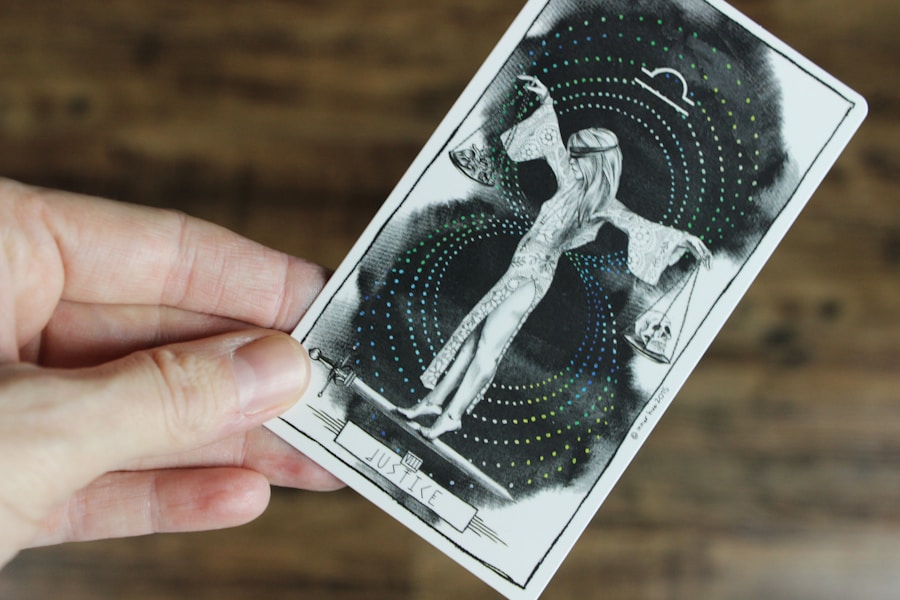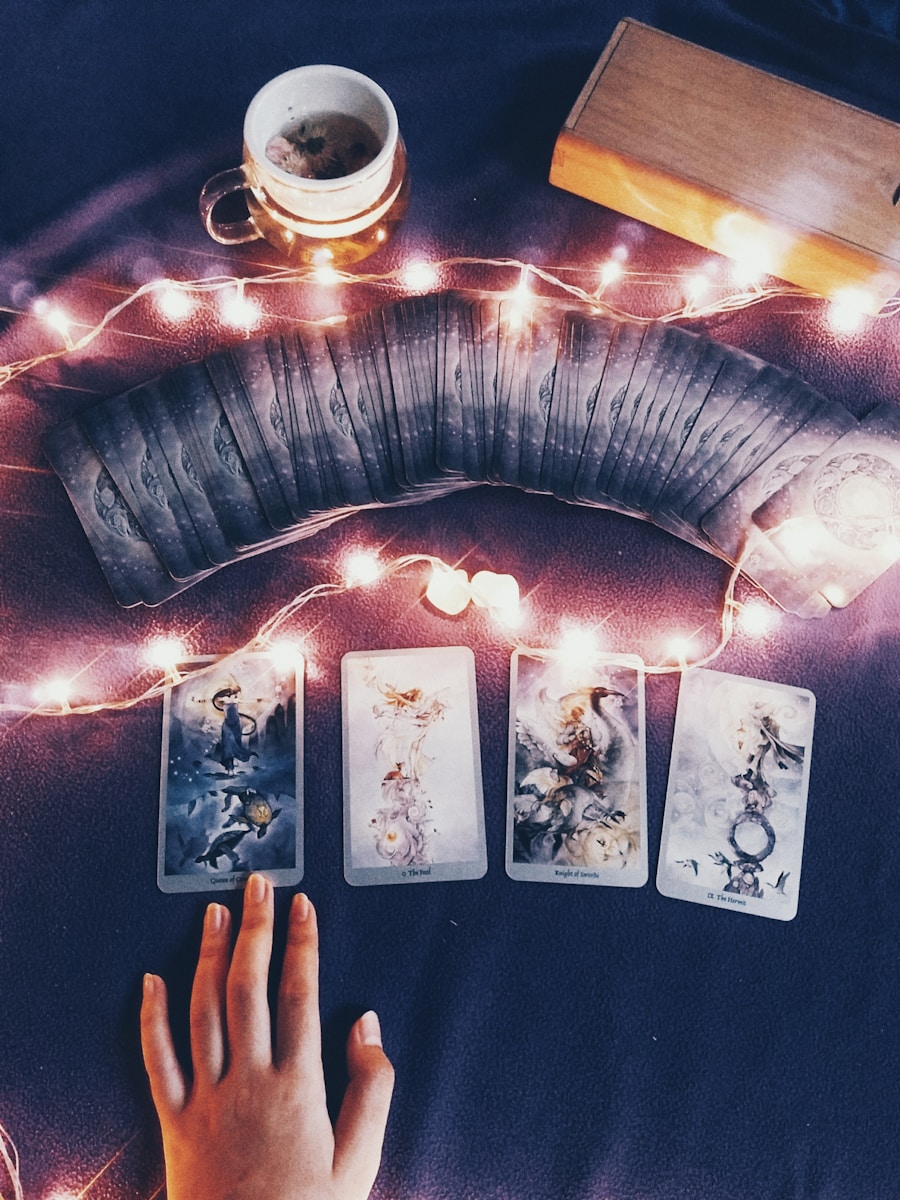To embark on your journey into the world of tarot, it is essential to grasp the fundamental concepts that underpin this ancient practice. Tarot cards are not merely tools for divination; they are a rich tapestry of symbolism and archetypes that can provide profound insights into your life and the human experience. Each card serves as a mirror, reflecting your inner thoughts, feelings, and circumstances.
By engaging with these cards, you can tap into your intuition and gain clarity on various aspects of your life. At its core, tarot consists of 78 cards divided into two main categories: the Major Arcana and the Minor Arcana. The Major Arcana comprises 22 cards that represent significant life events and spiritual lessons, while the Minor Arcana consists of 56 cards that delve into the everyday experiences and challenges you may face.
Understanding these distinctions is crucial as you begin to explore the meanings behind each card and how they relate to your personal journey. As you delve deeper into tarot, you will discover that it is not just about predicting the future; it is about understanding the present and making informed choices.
Summary
- Tarot is a tool for self-reflection and guidance, using a deck of 78 cards with symbolic imagery.
- When choosing a tarot deck, consider the artwork, symbolism, and personal connection to the cards.
- The Major Arcana represents significant life events and spiritual lessons, while the Minor Arcana focuses on day-to-day experiences.
- The Minor Arcana consists of four suits (Cups, Pentacles, Swords, and Wands) each with its own themes and meanings.
- Interpreting tarot spreads involves understanding the placement and relationship of the cards to each other in a reading.
Choosing the Right Tarot Deck
Understanding Your Tarot Style
Consider what draws you to tarot in the first place. Are you attracted to traditional imagery, or do you prefer a more modern or abstract approach? The aesthetics of the deck can significantly influence your connection to the cards, so take your time to browse through different options.
The Importance of the Guidebook
When choosing a deck, it is also essential to consider the accompanying guidebook. Some decks come with comprehensive guides that provide detailed explanations of each card’s meanings, while others may offer minimal information. If you are a beginner, opting for a deck with a thorough guidebook can be beneficial as it will help you navigate the complexities of interpretation.
Trust Your Instincts
Ultimately, trust your instincts; the right deck will resonate with you on a personal level, making your readings more meaningful and insightful.
Getting to Know the Major Arcana

The Major Arcana is often regarded as the heart of the tarot deck, representing significant life themes and spiritual lessons. Each card in this section tells a story, encapsulating universal experiences that resonate with many individuals. As you familiarise yourself with these cards, take note of their imagery and symbolism, as they often convey deeper meanings beyond their surface interpretations.
For instance, The Fool represents new beginnings and potential, while The Tower signifies upheaval and transformation.
Reflect on moments when you have encountered challenges or breakthroughs that align with the themes presented in these cards.
This personal connection will enhance your understanding and interpretation of the cards during readings. Remember that the Major Arcana cards often signify pivotal moments in your life’s journey, serving as reminders of growth and evolution.
Exploring the Minor Arcana
While the Major Arcana focuses on significant life events, the Minor Arcana delves into the everyday experiences that shape our lives. This section is divided into four suits: Cups, Pentacles, Swords, and Wands, each representing different aspects of human experience. Cups are associated with emotions and relationships, Pentacles relate to material aspects and finances, Swords represent thoughts and conflicts, while Wands embody creativity and action.
As you begin to explore the Minor Arcana, pay attention to how each suit interacts with your daily life. For example, if you frequently draw cards from the Cups suit, it may indicate a focus on emotional well-being or relationships at that time. Understanding the nuances within each suit will allow you to gain deeper insights during your readings.
Additionally, consider how the numbered cards (Ace through Ten) and court cards (Page, Knight, Queen, King) contribute to the overall narrative of your reading.
Interpreting Tarot Spreads
Once you have familiarised yourself with the individual cards, it is time to explore tarot spreads—specific layouts that help structure your readings. Different spreads serve various purposes; some may focus on a single question or issue, while others provide a broader overview of your current situation. The three-card spread is a popular choice for beginners, allowing you to explore past, present, and future influences related to a particular question.
As you lay out your cards in a spread, take a moment to observe their positions and relationships with one another. Each card’s placement can alter its meaning significantly; for instance, a card representing conflict may take on a different connotation when positioned in the past versus the future. Trust your intuition as you interpret these connections; often, your gut feeling will guide you toward understanding how each card contributes to the overall message of the reading.
Conducting a Tarot Reading

Conducting a tarot reading can be both an exciting and daunting experience for beginners. To create an environment conducive to reflection and insight, find a quiet space where you can focus without distractions. Before beginning your reading, take a moment to centre yourself—this could involve deep breathing or setting an intention for what you hope to gain from the session.
When formulating your question or intention for the reading, be specific yet open-ended. Instead of asking yes or no questions, consider framing your inquiry in a way that invites exploration and understanding. For example, instead of asking “Will I get this job?”, try “What do I need to know about my career path at this time?” This approach encourages deeper insights and allows for more nuanced interpretations of the cards drawn.
Avoiding Common Mistakes for Beginners
As with any new skill, beginners often encounter pitfalls when starting their tarot journey. One common mistake is relying too heavily on guidebooks without allowing for personal interpretation. While guidebooks can provide valuable insights into card meanings, remember that tarot is ultimately about connecting with your intuition.
Allow yourself to explore what each card means to you personally rather than adhering strictly to traditional interpretations.
Tarot is not an exact science; it is an art form that thrives on fluidity and intuition.
Be open to unexpected messages or insights that may arise during your readings. Embrace the uncertainty inherent in tarot; sometimes, the most profound revelations come from moments of ambiguity rather than clear-cut answers.
Incorporating Tarot into Your Daily Practice
Integrating tarot into your daily routine can enhance your self-awareness and personal growth. Consider setting aside time each day for a brief reading or reflection on a single card. This practice allows you to engage with the cards regularly while fostering a deeper connection with their meanings over time.
You might find that certain cards resonate more strongly during specific periods in your life, providing valuable insights into your emotional landscape. Additionally, journaling about your tarot experiences can be immensely beneficial. Documenting your readings allows you to track patterns over time and reflect on how different cards manifest in your life.
As you continue this practice, you may notice recurring themes or messages that can guide you in making decisions or navigating challenges. By incorporating tarot into your daily life in these ways, you will cultivate a richer understanding of yourself and the world around you. In conclusion, embarking on a tarot journey is an enriching experience that invites self-discovery and introspection.
By understanding the basics of tarot, choosing the right deck, familiarising yourself with both the Major and Minor Arcana, interpreting spreads effectively, conducting readings thoughtfully, avoiding common pitfalls, and incorporating tarot into your daily practice, you will unlock the potential for profound insights into your life’s journey. Embrace this mystical art with an open heart and mind; it has much to offer those willing to explore its depths.
FAQs
What is tarot?
Tarot is a form of divination that uses a deck of cards to gain insight into past, present, and future events, as well as to explore spiritual and psychological aspects of the self.
What is a tarot deck?
A tarot deck is a set of 78 cards, typically divided into the Major Arcana (22 cards) and the Minor Arcana (56 cards), each with its own symbolic imagery and meaning.
How is tarot used?
Tarot cards are often used for divination, meditation, self-reflection, and spiritual guidance. They can be used to gain insight into specific questions or to explore broader themes and patterns in one’s life.
Is tarot associated with any specific religion or belief system?
While tarot has historical ties to various mystical and esoteric traditions, it is not inherently tied to any specific religion or belief system. It can be used by people of diverse spiritual and cultural backgrounds.
Can anyone learn to read tarot cards?
Yes, anyone can learn to read tarot cards with dedication, practice, and an open mind. There are many resources available for beginners, including books, online courses, and workshops.
Is there a specific way to shuffle and lay out tarot cards?
There are various methods for shuffling and laying out tarot cards, and different readers may have their own preferences. Common techniques include shuffling the cards thoroughly, cutting the deck, and choosing a specific spread or layout for the cards.
Are there any ethical considerations when using tarot cards?
Some practitioners believe in ethical guidelines for tarot readings, such as obtaining consent from the querent (the person asking the question), maintaining confidentiality, and offering readings with compassion and respect. It is important to approach tarot readings with sensitivity and integrity.




















